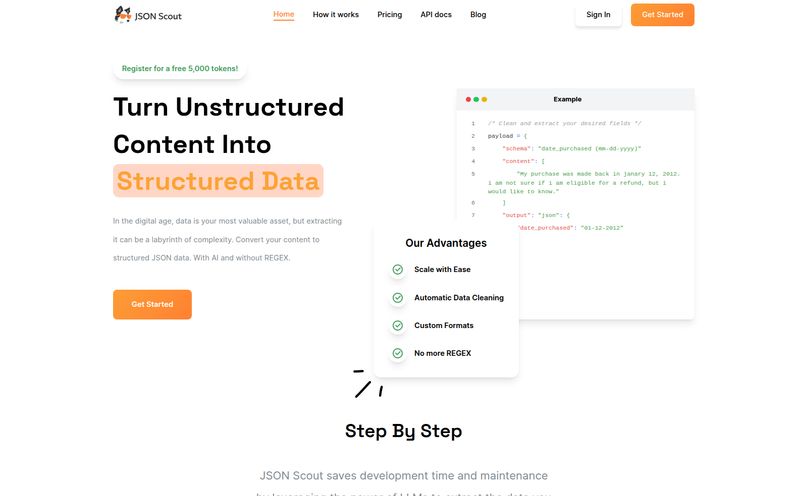In the world of SEO and digital marketing, you hear about a new “game-changing” tool every other Tuesday. Seriously. Most of them are just repackaged ideas with a slick new UI and a hefty subscription fee. You get jaded after a while. But every now and then, you hear a whisper about something that genuinely makes you lean in closer to your screen. For me, that whisper was RAGDrive.
The buzz was all about a no-code, on-device AI that could chat with your documents. And when I say on-device, I mean actually on your machine. No cloud uploads, no creepy data policies, no internet connection required. Your files stay on your hard drive, completely private. For anyone who handles sensitive client data, proprietary research, or just feels a bit weird about feeding their personal info into a global AI brain, this is the holy grail.
So I did what any self-respecting tech nerd would do. I opened a new tab, typed in RAGDrive.com, hit Enter, and… got a “Page not found” error. Huh. Not exactly the grand entrance I was expecting. Is it a ghost? A myth? A project that flew a little too close to the sun? I have no idea, but it got me thinking, and it certainly got me digging.
What Exactly is RAGDrive Supposed to Be?
Despite the digital tumbleweeds on their homepage, the concept behind RAGDrive is solid gold. It’s built on a technology called Retrieval-Augmented Generation, or RAG. In simple terms, RAG lets a language model 'read' your documents before answering a question. Instead of just pulling from its general knowledge, it uses your specific files as its source material. It's the difference between asking a random person on the street for legal advice versus asking your own lawyer who has your case file open on their desk.
RAGDrive aims to package this powerful tech into something anyone can use. A simple interface where you can just... talk to your PDFs, Word docs, and text files. All of it happening locally on your computer. Your data stays your data. It’s like having a private research assistant who lives in your laptop and has a perfect memory, but only for the things you’ve shown them. They have zero interest in what your cousin posted on Facebook.

Visit RAGDrive.com
The Allure of Local AI and Why We're All Obsessed
This whole movement towards local, on-device AI isn't just a trend for paranoids and privacy purists. It's a fundamental shift. We've spent the last decade getting comfortable with the cloud, but now we're starting to see the trade-offs. The constant privacy policy updates, the data breaches, the nagging feeling that you’re just a line item in a massive data-harvesting operation.
Local AI, and tools like the promised RAGDrive, offer a way out. They represent data sovereignty. For a freelancer, that means keeping client NDAs truly confidential. For a medical researcher, it means analyzing patient data without it ever leaving a secured network. It’s about control. This is a huge deal, and it’s why developers are scrambling to build user-friendly tools in this space. The demand is absolutely there.
A Closer Look at RAGDrive's Promised Features
So, assuming RAGDrive materializes from the digital mist, what's actually under the hood? Based on the info I could piece together, it’s a pretty compelling package.
True Offline Capability
This is the big one. The ability to run a powerful AI model without an internet connection is a superpower. Imagine being on a long flight and being able to query all your research papers. Or working from a cabin in the woods (we can dream, right?) and still having access to your entire project archive, conversationally. It's not just about privacy; it's about genuine utility in a world of sometimes-spotty connectivity.
The No-Code Revolution Hits Local AI
Until recently, setting up a local RAG system involved a whole lot of command-line tinkering, Python libraries, and a decent amount of hair-pulling. I’ve been there. It’s not for the faint of heart. RAGDrive promises to throw all that complexity out the window. A no-code interface democratizes the technology. It means my marketer friends, my writer colleagues, and even my dad could potentially use it. That’s how tech crosses the chasm from a niche hobby to a mainstream tool.
Hybrid Power: Local First, Cloud Second
Here’s a really smart bit of design. While RAGDrive is built for local processing, it supposedly allows for integration with external inference providers. Think of it like a hybrid car. For your everyday tasks—quick questions, summarizing a few documents—the efficient electric motor (your local machine) is perfect. But when you need to floor it—say, analyzing a 5,000-page archive—you can switch on the gas engine (a powerful cloud AI like one from Groq or Together AI) for that extra horsepower. This flexibility is brilliant, offering the best of both worlds: privacy by default, power on demand.
The Million-Dollar Question: What's the Catch?
Okay, I’m an optimist, but I’m also a realist. Nothing is ever perfect. And with RAGDrive, there are a few potential gotchas to consider, aside from its current vanishing act.
First, the hardware. Running AI models locally isn't magic; it takes computational muscle. While you might not need a supercomputer, you're probably not going to get a great experience on a ten-year-old Chromebook. The promise of on-device AI often comes with the unstated requirement of a decent CPU, plenty of RAM and maybe even a dedicated GPU. Something to keep in mind.
Second, the specifics on those external inferance provider integrations are a bit... fuzzy. Which providers will it support? How easy will the setup be? These details matter. An integration that takes an entire afternoon of API key hunting isn't much better than the old command-line methods.
And of course, the elephant in the room. The 404 page. It’s hard to bet on a horse that hasn't even shown up to the race yet. I'm hoping it's just a temporary glitch, a domain that hasn't propagated, or a stealth-mode launch that I'm just too early for. But it's a pretty big catch.
How Much Does RAGDrive Cost?
This is where the story gets even more interesting. From all indications, RAGDrive is intended to be free and open-source. Let that sink in for a moment. In an industry where everyone is trying to lock you into a monthly subscription, an open-source model is a breath of fresh, unmonetized air. It means a community can build around it, inspect the code for security flaws, and customize it to their heart's content. It’s a philosophy that builds trust, which is exactly what you want from a privacy-focused tool.
So, Is RAGDrive Vaporware or The Next Big Thing?
So, what’s the verdict? I'm cautiously optimistic. The ideas behind RAGDrive are not just good; they're exactly what the market needs right now. It sits at the perfect intersection of privacy concerns, the no-code movement, and the explosion in AI capabilities.
There are already some fantastic tools in this space, like Ollama paired with front-ends like AnythingLLM, that let you build a similar system if you're willing to get your hands a little dirty. RAGDrive's unique proposition is its promise of making that entire process effortless. If—and it's a big if—the team behind it can deliver on their vision and, you know, get their website online, this could easily become an essential tool for millions of people. I, for one, will be hitting refresh.
Frequently Asked Questions about RAGDrive
- 1. What is RAG technology anyway?
- RAG stands for Retrieval-Augmented Generation. It's a technique that allows an AI model to retrieve relevant information from a specific set of documents (like your files) before generating an answer. This makes its responses highly relevant and based on the facts you provide, not just its general knowledge.
- 2. Do I need to be a coder to use RAGDrive?
- No, that's its main selling point! RAGDrive is designed as a 'no-code' solution, meaning it should have a user-friendly graphical interface that lets you use it without writing a single line of code.
- 3. Is RAGDrive safe for sensitive documents?
- Because it's designed to run entirely on your local device, it's theoretically one of the safest ways to use AI with sensitive documents. Your files are never uploaded to an external server, so you maintain complete privacy and control.
- 4. What kind of computer do I need for RAGDrive?
- While official specs aren't available, on-device AI generally performs better with more modern computers. You'll likely want a machine with a decent processor (CPU), at least 16GB of RAM, and possibly a dedicated graphics card (GPU) for the best performance.
- 5. Is RAGDrive really free?
- Yes, all information points to it being a free and open-source project. This means you won't have to pay for the software, and its code will be publicly available for anyone to view and modify.
- 6. Where can I download RAGDrive?
- Currently, the official website, RAGDrive.com, appears to be down. The best advice is to keep an eye on that URL or search for the project on platforms like GitHub, where open-source projects are often hosted.
Conclusion
The story of RAGDrive is a fascinating one, even with its mysterious beginning. It represents a powerful and necessary shift towards private, user-controlled AI. It’s a reminder that the best technology empowers people without exploiting them. While we wait for the fog to clear and the website to appear, the idea of RAGDrive is a compelling north star for where AI should be heading. Here's hoping we all get to take it for a spin very, very soon.
Reference and Sources
- The (currently unavailable) official site: RAGDrive.com
- For building a DIY local RAG system: Ollama
- A great open-source RAG front-end: AnythingLLM
- A technical overview of RAG: Retrieval-Augmented Generation (Hugging Face)



